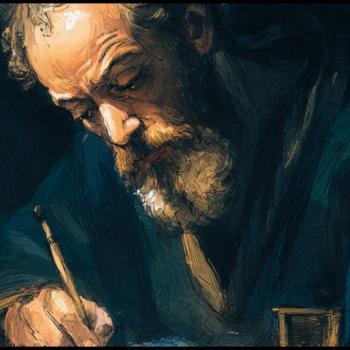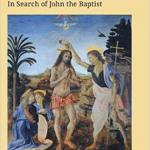![]()
According to the book of Revelation, when Jesus returns He will bring an army and strike down His enemies in a bloody war.
Before I get into this one, let’s start off with a few observations: First, this objection seeks to temper the numerous commands of Jesus to love our enemies, turn the other cheek and bless those who curse us by saying, “Look! Jesus gets violent in the end” as if this negates His clear commands to His disciples.
It does not.
Whatever Jesus has commanded, we must obey. Regardless of what might happen in the future, we here today are still expected to follow Jesus as our Lord. As He says, “Why do you call me ‘Lord, Lord’ and do not do what I say?” (Luke 6:46)
Secondly, just because Jesus acts as the Judge of all mankind—as He is seen doing in these Apocalyptic passages within Revelation—it does not follow that we are also allowed to act as judges.
In fact, we are specifically told by Jesus not to judge others, and we are reminded by Paul that our calling is to feed our enemies and to allow God to be the judge who repays them for any evils they may have done.
“Do not repay anyone evil for evil. Be careful to do what is right in the eyes of everyone. If it is possible, as far as it depends on you, live at peace with everyone. Do not take revenge, my dear friends, but leave room for God’s wrath, for it is written: “It is mine to avenge; I will repay,” says the Lord. On the contrary: ‘If your enemy is hungry, feed him; if he is thirsty, give him something to drink. In doing this, you will heap burning coals on his head.’ Do not be overcome by evil, but overcome evil with good.” (Romans 12:17-21)
So, what exactly is going on in Revelation? Why do we see a picture of Jesus that looks so radically different than what we see in the Gospels? How did He go from the suffering servant who said, “Father, forgive them for they know not what they do” to the guy on a white horse with a sword coming out of his mouth and wearing a robe dipped in blood?
Let’s look at Revelation Chapter 19 where most of this violent imagery is found.
Especially these verses:
“I saw heaven standing open and there before me was a white horse, whose rider is called Faithful and True. With justice he judges and wages war. His eyes are like blazing fire, and on his head are many crowns. He has a name written on him that no one knows but he himself. He is dressed in a robe dipped in blood, and his name is the Word of God. The armies of heaven were following him, riding on white horses and dressed in fine linen, white and clean. Coming out of his mouth is a sharp sword with which to strike down the nations. “He will rule them with an iron scepter.” He treads the winepress of the fury of the wrath of God Almighty. On his robe and on his thigh he has this name written: King of kings and Lord of lords.
“And I saw an angel standing in the sun, who cried in a loud voice to all the birds flying in midair, ‘Come, gather together for the great supper of God, so that you may eat the flesh of kings, generals, and the mighty, of horses and their riders, and the flesh of all people, free and slave, great and small.’
“Then I saw the beast and the kings of the earth and their armies gathered together to wage war against the rider on the horse and his army. But the beast was captured, and with it the false prophet who had performed the signs on its behalf. With these signs he had deluded those who had received the mark of the beast and worshiped its image. The two of them were thrown alive into the fiery lake of burning sulfur. The rest were killed with the sword coming out of the mouth of the rider on the horse, and all the birds gorged themselves on their flesh.” (Revelation 19:11-21)
Pastor Mark Driscoll famously celebrated the gore of Revelation at one time, saying that Jesus is depicted here as “a prize fighter with a tattoo down His leg, a sword in His hand and the commitment to make someone bleed.” For some Christians, this picture of Jesus is the one they prefer. Driscoll himself has said that he finds great comfort in this violent picture of Jesus because, “…that is a guy I can worship. I cannot worship the hippie, diaper, halo Christ because I cannot worship a guy I can beat up.”
For those who embrace a more violent Gospel, this seemingly violent Jesus serves as a welcome buffer against the Jesus they appear to fear the most: The Jesus who commands them to love their enemies and turn the other cheek. But what is really happening here? Is Jesus suddenly a warmonger who delights in slaughtering thousands of His enemies? What happened to the command that we should love our enemies? Are we held to a higher standard that God? Isn’t the admonition to love our enemies connected to God’s love for the just and the unjust? Aren’t we imitating God when we do this? How then can we explain these passages in light of the Sermon on the Mount?
First of all, we have to recognize that the book of Revelation is a different genre of Biblical literature than the Gospels are. In the same way that none of us would read a fantasy novel like “The Lord of the Rings” the same way we might read a romance novel, or a children’s story, we cannot read all genre’s of Biblical literate the same way either.
The book of Revelation is an example of apocalyptic literature. As such, it contains certain motifs and even borrows specific metaphors from other apocalyptic sections of books like Isaiah, Jeremiah, Ezekiel and Daniel. These images and metaphors are never to be taken literally. The original audiences for these writings did not believe that the smoke from a city that was judged by God would literally rise up forever and ever. They understood that this was hyperbole intended to illustrate that the finality of such judgment was absolute—as far as those who received that judgment were concerned. In the Gospels, even Jesus referred to these same apocalyptic metaphors whenever he prophesied the destruction of Jerusalem and the end of the Jewish age. (See Matthew 24, Mark 13 and Luke 21)
So, if we understand that the images we read about in Revelation are not intended to be literal, that can help us on one level, but we still may wonder what exactly is going on and what is it we are supposed to glean from passages like chapter 19?
First of all, Revelation 19 shows us a picture of Jesus as the Judge of the World. He has been given authority by the Father to judge the nations. The sword is not in His hand, as Driscoll claims. It is coming out of His mouth. Why is that? Why does Jesus pull a sword out of His mouth like a magician on a carnival sideshow? Again, because this isn’t meant to be taken literally. The sword that comes out of His mouth is symbolic. It tells us that the judgments spoken by Jesus have authority. His words hold the power of life and death. Those who follow His words have life. Those who reject His words will die.
Simply put: Jesus came warning his people that if they did not repent of their desire to violently rebel against their enemies [the Romans], that they would die a horrible death. He gave them another path to follow. He offered them the opportunity to disarm their oppressors by loving them, blessing them, going the extra mile and praying for them. He reminded them that the peacemakers are blessed, not the violent revolutionaries. He painted a very vivid picture for them of what this destruction would look like if they did not repent and turn around to follow in this path He was offering to them.
The judgment pronounced was not a warning of what Jesus would do to them if they did not obey Him, it was a warning of what they would reap if they did not stop sowing seeds of rebellion.
The robe Jesus wears is dipped in blood, but we must keep in mind that this blood is not the blood of His enemies. It is His own blood. Jesus has the authority to judge because He has suffered and died and risen from the dead to sit at the right hand of the Father. The Lamb who was slain is given the authority to open the seals of the scroll and to execute judgment. Only the Lamb who was slain is worthy. No one else.
Still, we have to admit that the imagery near the end of the chapter is quite gruesome. Birds are called to gorge themselves on the flesh of the slain. But, again, we have to remember that the connection between the apocalyptic hyperbole and the actual fulfillment is not the same thing.
When God prophesied against Egypt in Isaiah 19, we read that God will be seen “riding on a swift cloud” (v.1) as He comes to judge that nation. This is not a literal event. God is not saddling up a cloud and riding into battle against Egypt. The fulfillment of that image is when the armies of an invading nation ride into battle against Egypt and destroy her cities. In other words, these fantastic images of God (or Jesus) riding into battle against the people of the earth to do battle with them is fulfilled when the armies of other nations rise up and attack. There is always a practical fulfillment to these sorts of prophecies, as we see whenever God’s prophets proclaim judgment on nations using these kinds of apocalyptic hyperbole.
In Ezekiel 39 when God prophesies against Assyria (or Gog) He says “I will give you to the birds of prey of every sort and the beasts of the field to be devoured.” (v.4) This is the exact same apocalyptic hyperbole used in Revelation 19 to describe the fate of those who will be judged by the words spoken by Jesus against those who reject Him as their King.
Simply put, Jesus is the righteous judge. He has said that those who reject Him will perish. This is the sword that comes out of His mouth. Those who refuse to repent and to take up their cross to follow the enemy-loving path of Jesus will die by the sword. The author of Revelation borrows violent apocalyptic hyperbole found in the Old Covenant scriptures to illustrate this truth. He expresses it in dramatic, yes even violent metaphorical terminology, but if we boil everything down all that is really happening in Revelation 19 is that Jesus, who is the Judge, speaks life to those who love Him and those who reject that life receive the fruit of their decisions, which is death.
But Jesus takes no pleasure in the death of anyone. Not even those who reject Him. His love for you is the same as His love for Hitler. That is to say: enough to die for both of you and to extend to everyone the same mercy, grace and forgiveness.
The images of Jesus riding into battle on a white horse with a sword coming out of His mouth are meant to call people to repentance. It is intended to warn those who have rejected Jesus as Lord of their ultimate fate—which is certain death—if they refuse to accept the life that is available only through Christ.
We know, by the way, that this judgment was fulfilled against those who rejected Christ’s teachings in AD 70 when the Roman army surrounded Jerusalem and destroyed the city, and the Temple. Those who rejected the command to love their enemies [the Romans] and who refused to turn the other cheek, go the extra mile and put away their swords were cut down as Jesus warned them they would be. Those who followed Jesus were saved from this destruction. They escaped this fate by trusting in His teaching and putting this love into practice right up until the very end.
The irony is that those who missed Jesus the first time were looking for a violent warrior Messiah who would come riding in to rescue them from their oppressors with bloody violence. If we look around us today, I think we can see that not very much has changed.
**
Keith Giles is the author of “Jesus Untangled: Crucifying Our Politics To Pledge Allegiance To The Lamb” and co-host of the Heretic Happy Hour Podcast. He and his wife live in Orange, CA with their two sons and are part of a house church that gives away 100% of the offering to help the poor in their community.













